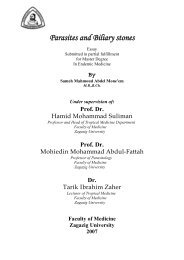E. Coli
E. Coli
E. Coli
You also want an ePaper? Increase the reach of your titles
YUMPU automatically turns print PDFs into web optimized ePapers that Google loves.
Review of Literature<br />
suggested that E.coli spread rapidly after hatching. Feed is often<br />
contaminated with pathogenic coliform but these can be destroyed by<br />
hot pelliting process. Rodent dropping often contain pathogenic<br />
coliforms.<br />
Blanco et al. (1997) established a study for detecting the<br />
serogroups of E.coli that causes avian colibacillosis in spain. The<br />
serogroups of 625 avian E.coli isolated between 1992-1993 were<br />
determined. The 458 E.coli from chickens with septicemia belonged<br />
to 62 different 0 serogroups; however, 59% were of 18 serogroups (O:<br />
1, O:2, O:5, O:8, O:12, O:14, O:15, O:18, O:20, O:53, O:78, O:81,<br />
O:83, O: 102, O:103, O:115, O:116 and O:132). The high prevalence<br />
of O:18, O:81, O:115, O:116, O:132 isolates was not expected and<br />
many indicate the emergence of five new serogroups associated with<br />
avian colibacillosis not yet reported.<br />
El-Morsi (1998) examined twenty five liver samples from<br />
poultry and found that 5 samples were positive to E.coli by incidence<br />
of 20%. The isolated serotypes of E.coli from liver samples were 2<br />
untypable (40%), 2 belonged to O111:K58 (40%) and one was O126:<br />
K71 (20%).<br />
Fisher et al. (1998) induced E. coli septicemia in broilers in<br />
order to determine if lesions of acute septicemia could be grossly<br />
detected in visceral organs of broiler carcasses. Increased spleen and<br />
liver weight were observed during the acute phase of septicemia. Air<br />
saculitis, pericarditis and periphepatitis were observed also during the<br />
acute phase.<br />
5
















